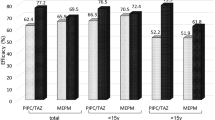Summary
A study of the safety and efficacy of parenteral tobramycin and cephalothin in the treatment of suspected sepsis in neutro-penic children (< 1000 polymorphonuclear leukocytes/mm3 of blood) with various underlying malignancies was undertaken. Twenty episodes of suspected sepsis in 19 febrile children with cancer were treated with parenteral tobramycin and cephalothin for a total of one to 80 days. Each was followed closely for renal, hepatic, bone marrow, and auditory toxicity. In 14 of the 20 episodes of suspected sepsis, a favourable clinical response was achieved within five days of initiation of antibiotics. These included a Proteus mirabilis urinary tract infection and E.coli sepsis. No clinical improvement was noted in the remaining six episodes. In four of the six episodes, clinical deterioration was felt to be secondary to the underlying malignancies. The remaining two episodes included one with E.coli sepsis which ended fatally within six hours of admission, while the other included a nosocomial infection with Eikenella corrodens. No evidence of renal, auditory, hepatic, bone ma-row, or vestibular toxicity was noted either during or following antibiotic therapy. Results of this study suggest the safety and efficacy of combination tobramycin and cephalothin in the treatment of suspected sepsis in neutropenic febrile children with malignancies.
With the recent advances in the treatment of childhood cancer, children with previously uniformly fatal neoplasms now represent potential cures. Because the aggressive antineoplastic therapy required to achieve long-term survival is often associated with immunologic suppression, these children are susceptible to overwhelming infection. Such infections are usually caused by gram-negative bacteria such as Escherichia coli, Klebsiella Enterobacter species, and Pseudomonas aeruginosa (Klastersky et al, 1973a). Despite continued improvements in antimicrobial therapy, the mortality rate from infection in children with cancer remains high. The major predisposing factor to infection in these children is neutropenia, defined here as < 1000 polymorphonuclear neutrophils (PMN’s) per mm of blood. Neutropenia may result from the underlying malignancy or may be secondary to radiotherapy or chemotherapy. Since neutropenic children frequently do not manifest the usual inflammatory response to infection, fever is often the only presenting sign of serious infection (Yates, 1973). Because fever in a neutropenic cancer patient may indicate possible sepsis and herald rapid clinical deterioration and death, many institutions treat such patients with parenteral broad-spectrum antibiotics after appropriate culturing but prior to identification of a pathogen. Although various combinations of broad-spectrum antibiotics have been used to treat possible sepsis in neutropenic cancer patients, none has been proved to be uniformly efficacious (Klastersky et al, 1973a).
Tobramycin, an aminoglycoside antibiotic produced by Streptomyces tenebrarius, has been shown to be effective both in vitro and in vivo against many strains of gram-negative organisms, including some strains of Pseudomonas aeruginosa resistant to gentamycin (Klastersky et al, 1973b- Valdivieso et al, 1974; Naber et al, 1973). Cephalothin is effective in its antimicrobial activity against many pathogenic gram-positive organisms resistant to tobramycin (Herrell, 1973). In addition, tobramycin has been shown to act synergistically with certain cephalosporins against selected bacterial species (Hyams et al, 1974). For these reasons, it was decided to evaluate the safety and efficacy of the combination of tobramycin and cephalothin in febrile neutropenic children with cancer and suspected sepsis.
Access this chapter
Tax calculation will be finalised at checkout
Purchases are for personal use only
Preview
Unable to display preview. Download preview PDF.
Similar content being viewed by others
References
Brummett, R.E., Himes, D., Saine, B. and Vernon, J. (1972), Archives of Otolaryngology, 96, 505.
Herrell, W.E. (1973) Clinical Medicine, 80, 12.
Hyams, P.J., Simberkoff, M.S. and Rahal, J.J. (1974 Antimicrobial Agents and Chemotherapy, 5, 571.
Klastersky, J., Daneau, D., Henri, A., Cippel, R. and Hensgens, C. (1973a), European Journal of Cancer, 9, 407.
Klastersky, J., Daneau, D. and De Maertelaer, V. (1973b), Clinical Pharmacology and Therapeutics, 14, 104.
Naber, K.G., Westenfelder, S.R. and Madsen, P.O. (1973) Antimicrobial Agents and Chemotherapy, 3, 469.
Rodriguez, V., Burgess, M. and Bodey, G.P. (1973) Cancer, 32,1007.
Valdivieso, M., Horikoshi, N., Rodriguez, V. and Bodey, G.P. (1974), Americal Journal of the Medical Sciences, 268, 149.
Yates, J. (1973), Seminars in Drug Treatment, 3, 27.
Author information
Authors and Affiliations
Editor information
Editors and Affiliations
Rights and permissions
Copyright information
© 1976 Plenum Press, New York
About this chapter
Cite this chapter
Cohen, J.D., Miale, T.D. (1976). Parenteral Tobramycin and Cephalothin in the Treatment of Suspected Sepsis in Neutropenic Children. In: Williams, J.D., Geddes, A.M. (eds) Chemotherapy. Springer, Boston, MA. https://doi.org/10.1007/978-1-4613-4346-2_18
Download citation
DOI: https://doi.org/10.1007/978-1-4613-4346-2_18
Publisher Name: Springer, Boston, MA
Print ISBN: 978-1-4613-4348-6
Online ISBN: 978-1-4613-4346-2
eBook Packages: Springer Book Archive




